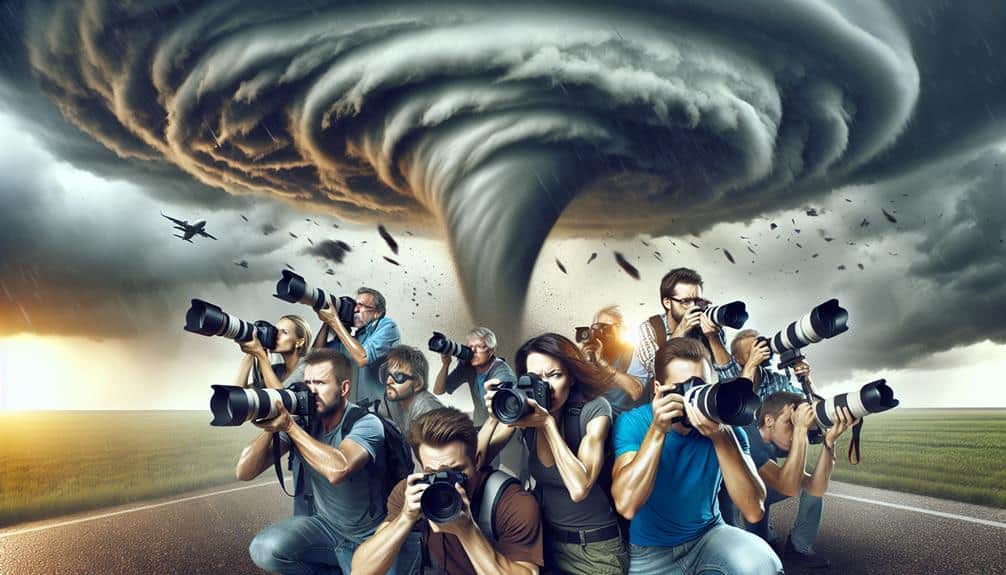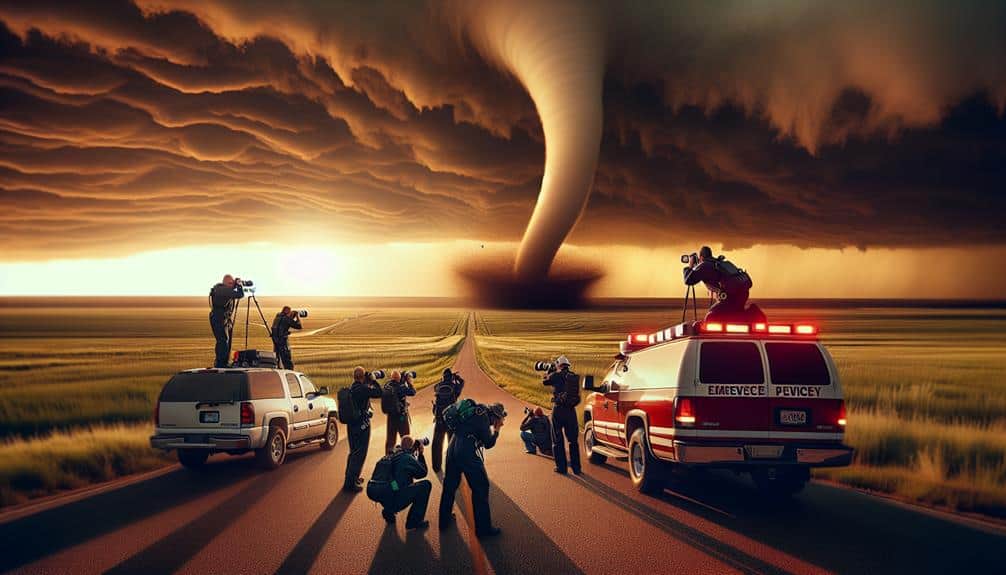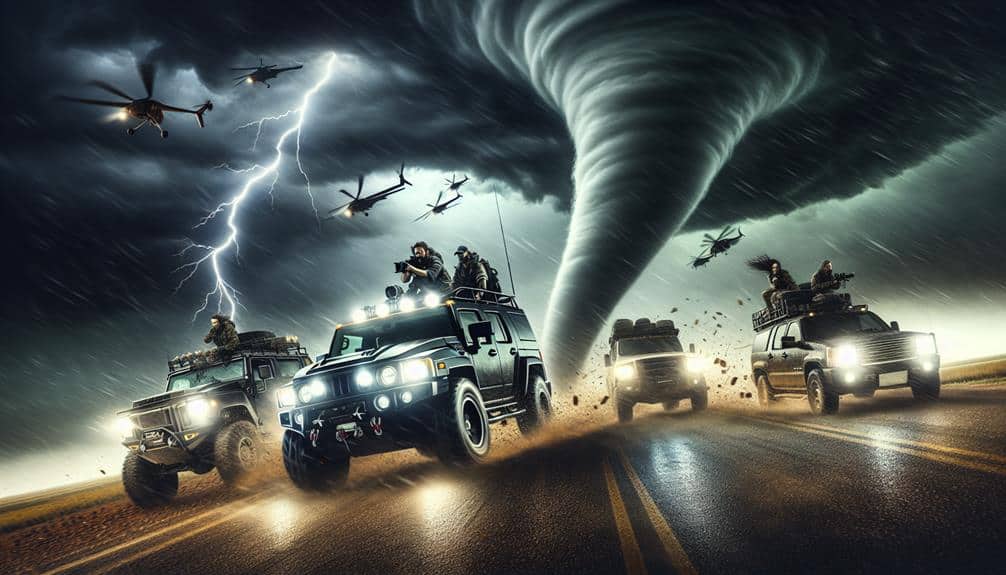We analyze storm chaser storm predictions to enhance their accuracy and effectiveness, which is vital for public safety. Precise data from storm chasers allows us to refine predictive models, ultimately reducing damage and loss of life. Emergency response teams rely on this information for efficient resource deployment and timely evacuations. Media outlets utilize accurate storm predictions to provide real-time updates, increasing public preparedness. Advances in radar and predictive algorithms further optimize these predictions. By understanding these complexities, we improve our proactive measures against severe weather events, enhancing community resilience and safety. Interested parties will gain further insights into this essential topic.
Key Points
- Storm chasers provide real-time data crucial for refining predictive models and enhancing forecast accuracy.
- High-resolution observations from storm chasers offer detailed insights into storm behavior and development.
- Storm chasers' data helps emergency response teams deploy resources and issue timely warnings effectively.
- Media benefit from storm chasers' firsthand information, improving the immediacy and accuracy of weather reports.
Importance of Accurate Predictions
Accurate storm predictions are vital for minimizing damage, saving lives, and allocating resources effectively. Our analysis hinges on precise data and validated research to guarantee we provide reliable forecasts. By rigorously testing and verifying our models, we enhance their accuracy, which is pivotal for community preparedness.
When predictions are on target, communities can better plan evacuations, fortify structures, and distribute emergency supplies efficiently.
Through continuous research validation, we refine our algorithms, incorporating real-time weather data and historical storm patterns. This iterative process improves our predictive capabilities, allowing us to alert communities well in advance.
For instance, analyzing past storm data enables us to identify trends and anomalies, leading to more precise forecasts. Accurate predictions empower communities to take proactive measures, reducing the potential for catastrophic outcomes.
Moreover, our focus on community preparedness ensures that residents have the necessary information and resources to respond effectively. By fostering a culture of preparedness, we help communities maintain a sense of autonomy and readiness.
Ultimately, accurate storm predictions are a cornerstone of effective disaster management, enabling timely interventions and safeguarding lives and property. Our commitment to precision and validation underscores the importance of these predictions in mitigating storm impacts.
Impact on Public Safety
Timely and precise storm predictions greatly improve public safety by enabling swift and informed decision-making. When storm chasers provide accurate data, we can enhance public awareness, ensuring communities are well-informed about potential threats. This heightened awareness allows individuals to take appropriate actions, safeguarding themselves and their properties.
Detailed storm predictions contribute significantly to emergency preparedness. By analyzing these forecasts, local governments and emergency services can develop more effective contingency plans. This preparation can include the strategic allocation of resources, such as deploying emergency personnel to high-risk areas and ensuring shelters are ready to accommodate those affected. Additionally, businesses can minimize economic losses by securing assets and protecting critical infrastructure.
Accurate predictions also empower us with the freedom to make personal choices that improve our safety. For instance, knowing the exact timing and severity of a storm lets us decide whether to evacuate or stay put. This autonomy is essential in maintaining a sense of control in potentially chaotic situations.
Role in Emergency Response
Leveraging storm chasers' data, emergency response teams can efficiently deploy resources and initiate timely interventions, greatly enhancing their operational effectiveness. By integrating real-time storm data, we can optimize disaster response strategies to minimize the impact on affected communities. This data-driven approach allows us to anticipate storm trajectories and potential damage zones, enabling us to allocate resources where they're most needed.
When analyzing storm chaser reports, we gain critical insights into the severity and progression of storms. This information is crucial for community preparedness, as it helps us issue accurate and timely warnings, reducing the risk to life and property. High-resolution data from storm chasers provides a granular view of weather events, which is essential for crafting targeted emergency response plans.
Moreover, storm chasers' firsthand accounts and technological inputs bridge gaps in traditional meteorological data. By leveraging these insights, we enhance our situational awareness and improve coordination with local authorities and emergency services. This seamless integration of data into our disaster response framework assures that our actions are both swift and effective, safeguarding our communities' freedom and resilience in the face of natural disasters.
Influence on Media Reporting
Storm chasers' detailed observations and real-time data greatly enhance the accuracy and immediacy of media weather reports. By providing firsthand information on storm development, trajectory, and intensity, they enable broadcasters to deliver more precise and timely updates. This heightened accuracy in media coverage is essential in shaping public perception, as people rely on these reports to make informed decisions about their safety and daily activities.
When we analyze storm chaser data, we notice a significant reduction in the lag between storm events and their reporting. This immediacy guarantees that the information disseminated through media channels is current, reducing the likelihood of outdated or inaccurate reporting. Accurate media coverage, in turn, fosters public trust, making people more likely to heed warnings and take necessary precautions.
Moreover, storm chasers often capture vivid imagery and compelling narratives, which media outlets utilize to engage their audience. This not only boosts viewership but also raises awareness about the severity and potential impact of storms. Consequently, the public's perception of weather events becomes more informed and nuanced, leading to better preparedness and resilience. Media coverage, bolstered by storm chasers' contributions, plays a central role in public safety and awareness.
Technological Advancements

We've seen significant improvements in storm prediction thanks to advanced radar systems, predictive modeling algorithms, and real-time data collection.
These technologies allow us to track storm developments with greater accuracy and provide timely warnings.
Advanced Radar Systems
Cutting-edge radar systems have greatly improved our ability to predict storm behavior with enhanced accuracy and timeliness. By utilizing advanced radar technology, we can now track storms more effectively, enabling us to make more informed decisions and take timely actions. Modern radar systems provide us with detailed data that enhance storm tracking.
- Doppler Radar: Measures the velocity of precipitation, helping us grasp storm dynamics.
- Phased Array Radar: Offers swift scanning capabilities, providing near-real-time updates.
- Dual-Polarization Radar: Differentiates between types of precipitation, boosting forecast precision.
These advancements in radar technology have transformed storm tracking. Utilizing Doppler radar, we can detect wind patterns within storms, which is vital for identifying potential tornado formations. Phased array radar's rapid updates allow us to track fast-evolving weather events more accurately. Dual-polarization radar gives us a clearer picture of precipitation types, enhancing our predictive capabilities.
The integration of these advanced radar systems enhances our situational awareness and empowers us with the data we need to act decisively. In an era where freedom and safety go hand in hand, leveraging these technologies ensures we're better prepared for whatever nature throws our way.
Predictive Modeling Algorithms
Leveraging sophisticated predictive modeling algorithms, we can now simulate storm behavior with unparalleled accuracy and speed. These advancements in algorithm development allow us to analyze vast amounts of meteorological data and extract meaningful patterns that enhance our storm predictions. By integrating machine learning techniques, we can refine these models continuously, boosting their predictive power.
Our approach involves rigorous data analysis, utilizing historical weather data, real-time observations, and atmospheric variables. This extensive dataset feeds into our algorithms, enabling us to identify correlations and causations that were previously undetectable. For example, by analyzing wind patterns, humidity levels, and temperature gradients, our models can predict storm paths and intensities with exceptional precision.
The freedom to predict storm behavior accurately empowers communities to take proactive measures, mitigating potential damage and saving lives. We're not just relying on raw data but transforming it into actionable insights. Our predictive modeling algorithms are the backbone of this transformation, providing a critical tool for storm chasers and meteorologists alike.
As we continue to refine these algorithms, we push the boundaries of what's possible in weather prediction, leading to more informed decisions and enhanced preparedness for natural disasters.
Real-Time Data Collection
Harnessing real-time data collection technologies, we guarantee our predictive models are always fueled by the most current and accurate information available. This capability is crucial for ensuring data accuracy and enhancing our ability to make informed decisions swiftly.
Real-time monitoring allows us to capture and analyze weather patterns as they unfold, providing invaluable insights that static data simply can't offer.
To deepen our understanding and improve our models, we rely on several cutting-edge technologies:
- Doppler radar systems: These provide high-resolution data on storm dynamics, including wind speed and direction.
- Satellite imagery: Real-time satellite data offers a detailed view of storm development and movement.
- Automated weather stations: These stations continuously collect localized data on temperature, humidity, and atmospheric pressure.
Training and Education
In order to accurately predict storms, we must undergo thorough training and obtain specialized education in meteorology and data analysis. Our journey begins with detailed meteorology training, covering both theoretical knowledge and practical field experience. By immersing ourselves in hands-on learning environments, we cultivate a deep understanding of forecasting techniques essential for storm prediction.
Field experience is essential. We actively participate in storm-chasing expeditions to observe atmospheric phenomena in real time. These excursions enable us to apply classroom knowledge to real-world scenarios, enhancing our analytical capabilities. Through constant interaction with unpredictable weather conditions, we refine our skills in interpreting meteorological data and predicting storm behavior.
Our curriculum incorporates advanced data analysis, focusing on state-of-the-art tools and methodologies. We learn to analyze vast datasets from radar, satellite imagery, and weather models. This analytical proficiency empowers us to identify patterns and anomalies that precede severe weather events.
In addition to technical skills, we emphasize critical thinking and decision-making under pressure. Storm prediction demands quick, accurate assessments, often in high-stakes situations. Our training ensures we're prepared to make informed decisions that prioritize safety and accuracy.
Ultimately, our specialized education and thorough training form the foundation of exact storm predictions, granting us the freedom to navigate and understand the complexities of severe weather.
Frequently Asked Questions
What Equipment Do Storm Chasers Typically Use During Their Expeditions?
We rely on equipment essentials like radar, tracking technology, and GPS. Our vehicle modifications include reinforced frames and weather sensors. Communication devices, such as radios and satellite phones, maintain constant contact and data sharing during expeditions.
How Do Storm Chasers Fund Their Operations and Research?
We fund our operations through a mix of private donations, sponsorships, and research grants. These funding sources provide the necessary capital for equipment, travel, and data analysis, enabling us to pursue our passion for storm chasing.
What Qualifications Are Required to Become a Professional Storm Chaser?
To become a professional storm chaser, we need meteorology expertise and significant field experience. Advanced degrees in atmospheric sciences, internships, and hands-on training are essential. This combination guarantees accurate data collection, supporting our pursuit of freedom in research.
How Do Storm Chasers Stay Safe During Extreme Weather Events?
We stay safe by strictly adhering to safety precautions and emergency protocols. We use real-time data, GPS, and communication systems to navigate extreme weather events, ensuring we maintain situational awareness while minimizing risk to our team.
What Role Do Storm Chasers Play in Climate Change Research?
We gather storm data to enhance climate science, analyzing changing weather patterns. Our research impact helps predict future trends, contributing essential insights into climate change. Accurate data empowers informed decisions, ensuring freedom from unforeseen extreme weather events.


